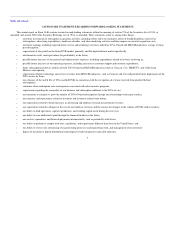TiVo 2007 Annual Report Download - page 14
Download and view the complete annual report
Please find page 14 of the 2007 TiVo annual report below. You can navigate through the pages in the report by either clicking on the pages listed below, or by using the keyword search tool below to find specific information within the annual report.
Table of Contents
• Telecommunications: Telecommunications operators have deployed DVR technology in connection with the provision of television services to
consumers either in partnership with other television providers, such as Verizon's FIOS service, AT&T's U-verse service or through partnerships
with both DIRECTV (Qwest, Verizon) or Dish (AT&T).
Consumer Electronics Competitors. We compete against several types of products with basic time-slot based recordings or enhanced electronic
program guide (EPG) based DVR functionality offered by consumer electronics companies. These products record a television signal output from a cable,
satellite, or antenna, including internationally through digital over-the-air standards such as DVB-T.
• Standalone DVRs and hard drive-equipped DVD recorders, TVs, and game consoles: Several consumer electronics companies, including
Panasonic and Sony, produce DVD recorders with hard drives. In addition, several consumer electronics companies, including RCA and Toshiba,
offer TVs that can connect to external hard drives to allow for recording of television programming. Some of these TVs offer CableCARD
functionality, allowing the receipt of encrypted digital cable programming without the need for a digital cable set-top box. In general, these hard-
drive equipped DVD recorders and TVs do not require DVR service fees and offer basic DVR functionality. In the future, companies such as
Sony and Microsoft could incorporate DVR technology into their video game consoles, and Microsoft has now enabled the digital delivery of
video programming over the internet to its game console.
• Personal computers with DVR software: Microsoft's Windows XP Media Center and Vista Editions contain expanded digital media features
including enhanced DVR functionality. PC manufacturers including Dell and Hewlett Packard offer PCs running this Microsoft software and
other PC manufacturers such as Apple Computer may offer similar functionality in the future. Replay TV now offers its DVR service as a
software program which can be loaded onto a personal computer similar to products such as MythTV and SnapStream.
Licensing Competitors. Our licensing revenues depend upon both our ability to successfully negotiate licensing agreements with our consumer
electronics and service provider customers and, in turn, upon our customers' successful commercialization of their underlying products. In addition, we face
competition from companies such as Microsoft, Gemstar, OpenTV, NDS, D&M Holdings, Digeo, Gotuit, and 2Wire, which have created competing digital
video recording technologies. Such companies may offer more economically attractive licensing agreements to service providers and manufacturers of DVRs.
Established Competition for Advertising Budgets. Digital video recorder services, in general, and TiVo, specifically, compete with other advertising
media such as print, radio, television, Video on Demand, internet, and other emerging advertising platforms for a share of advertisers' total advertising
budgets. If advertisers do not perceive digital video recording services, in general, and TiVo specifically, as an effective advertising medium, they may be
reluctant to advertise on the TiVo service. In addition, advertisers may not support or embrace the TiVo technology due to a belief that our technology's
ability to fast-forward through commercials will reduce the effectiveness of general television advertising.
Audience Research Competitors. We compete with advertising research companies such as Nielsen, TNS, RenTrak, and TRA for research spend from
advertisers, advertising agencies, and television networks. These companies have all announced intentions to provide second-by-second viewership
information based on data from digital cable set-top-boxes and satellite set-top-boxes. The type of research we provide is a discretionary purchase. If
advertisers, advertising agencies, and television networks perceive the information provided by these companies to be more valuable, they may invest in those
services rather than ours, or they may choose not to purchase this type of information at all.
Patents and Intellectual Property
We have filed patent applications relating to many critical aspects of the design, functionality, and operation of TiVo products and services. We have
been awarded approximately 121 foreign and domestic patents and have approximately 182 foreign and domestic patent applications pending. We have also
filed patent applications related to technology that we may incorporate in future versions of our products and services. Patents we hold the rights to include:
• U.S. patent number 6,327,418, entitled Method and Apparatus Implementing Random Access and Time-Based Functions on a Continuous Stream
of Formatted Digital Data, originally filed on April 3, 1998, which describes a method of controlling streaming media
12
























